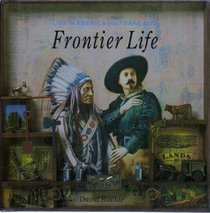Helpful Score: 1
The author, David Ritchie, made a clear point that life in these United States was vastly different than it is today. However, he adds a significant sidebar: Life in the US was NOT like the romanticized images in books and (particularly) movies.
The people who braved the perilous journey across America were truly astounding individuals. They had to fight their way through hostile Indians, marauding wild animals and unfamiliar land masses. When they arrived at their destination, they had to cut out a place (from the heavily wooded areas) to establish their log houses, start gardens (to feed themselves) and herd cattle or grow crops for ready cash. Most pioneers lived out in the weather in or under their wagons for a couple of years while they constructed their tiny log houses.
The pioneer family was a city unto itself. Any repairs that had to be made were made by the pioneers. There were few competent doctors, so they learned to take care of illnesses on their own. They could not rely on others because there were no neighbors for perhaps 10 to 100 miles, or more.
An entire family of 6 to 12 people lived for years (meaning they ate, slept, cooked and worked together) in a space about the same size as a childs bedroom today. In 1790, 95% of the population in America worked on farms; by 1910, that number had dropped to 30%. Amazingly enough, by 1985, the number of farmers dropped to a mere 3% of the population.
This meant that America, a nation proud of their ability to adjust to change, had to adjust to the demise of the family farm and adjust to industrialization. The folks who stopped farming generally went to live in cities.
Before long, big business formed monopolies that strangled the farmers charging them too much to transport their goods to markets and extracting too many middle-man fees so that the farmer could not sell his goods at a profit. This lead to the farmers starting The Grange an organization established to bend the ear of state government officials to create more favorable conditions for farmers.
The book spends considerable time talking about the factors that created so much change in the American worker and his family. Some of the discussion was more than I was interested in but there is one thing that is absolutely superb about this book almost every page has a photograph or etching depicting conditions in America during the years under discussion. They are not to be missed because they add so much to the understanding of America at that time.
The people who braved the perilous journey across America were truly astounding individuals. They had to fight their way through hostile Indians, marauding wild animals and unfamiliar land masses. When they arrived at their destination, they had to cut out a place (from the heavily wooded areas) to establish their log houses, start gardens (to feed themselves) and herd cattle or grow crops for ready cash. Most pioneers lived out in the weather in or under their wagons for a couple of years while they constructed their tiny log houses.
The pioneer family was a city unto itself. Any repairs that had to be made were made by the pioneers. There were few competent doctors, so they learned to take care of illnesses on their own. They could not rely on others because there were no neighbors for perhaps 10 to 100 miles, or more.
An entire family of 6 to 12 people lived for years (meaning they ate, slept, cooked and worked together) in a space about the same size as a childs bedroom today. In 1790, 95% of the population in America worked on farms; by 1910, that number had dropped to 30%. Amazingly enough, by 1985, the number of farmers dropped to a mere 3% of the population.
This meant that America, a nation proud of their ability to adjust to change, had to adjust to the demise of the family farm and adjust to industrialization. The folks who stopped farming generally went to live in cities.
Before long, big business formed monopolies that strangled the farmers charging them too much to transport their goods to markets and extracting too many middle-man fees so that the farmer could not sell his goods at a profit. This lead to the farmers starting The Grange an organization established to bend the ear of state government officials to create more favorable conditions for farmers.
The book spends considerable time talking about the factors that created so much change in the American worker and his family. Some of the discussion was more than I was interested in but there is one thing that is absolutely superb about this book almost every page has a photograph or etching depicting conditions in America during the years under discussion. They are not to be missed because they add so much to the understanding of America at that time.




